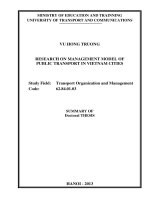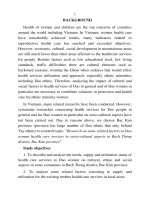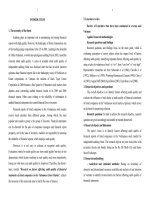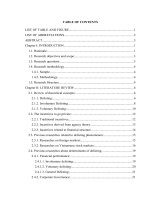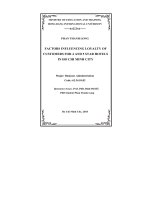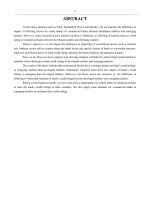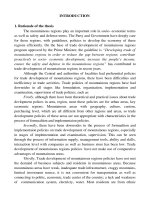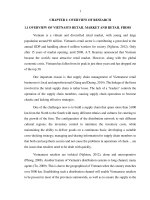Summary of Doctoral thesis: Research on factors influencing supply chain operation in Vietnam retail firms
Bạn đang xem bản rút gọn của tài liệu. Xem và tải ngay bản đầy đủ của tài liệu tại đây (265.35 KB, 25 trang )
1
CHAPTER 1: OVERVIEW OF RESEARCH
1.1 OVERVIEW OF VIETNAM'S RETAIL MARKET AND RETAIL FIRMS
Vietnam is a vibrant and diversified retail market, with young and large
population around 90 million. Vietnam's retail sector is contributing a great deal to the
annual GDP and handling about 6 million workers for society (Nghiem, 2012). Only
after 15 years of market opening, until 2008, A.T. Kearney announced that Vietnam
became the world's most attractive retail market. However, along with the global
economic crisis, Vietnam has fallen from its peak in just three years and has dropped out
of the top 30.
One important reason is that supply chain management of Vietnamese retail
businesses is local and unprofessional (Giang and Duong, 2014). The linkage of the firms
involved in the retail supply chain is rather loose. The lack of a "leaders" controls the
operation of the supply chain members, causing supply chain operations to become
chaotic and lacking effective strategies.
One of the challenges now is to build a supply chain that spans more than 3,000
km from the North to the South with many different ethnics and cultures for catering to
the growth of the firm. The configuration of the distribution network to suit different
cultural regions; the inventory control to minimize the inventory costs, while
maintaining the ability to deliver goods on a continuous basis; developing a suitable
cross-docking strategy; managing and sharing information for supply chain members so
that both can keep theirs secrets and not cause the problems in operations of chain ... are
the issues that retailers need to be dealt with quickly.
Vietnamese retailers are isolated (Nghiem, 2012), alone and uncooperative
(Phong, 2008). Another feature of Vietnam's distribution systems is long channel, many
agents (Tu, 2009). This is due to the geographical of Vietnam when the country stretches
over 3000 km. Establishing such a distribution channel will enable Vietnamese retailers
to be present in most of the provinces nationwide, as well as to ensure the supply to the
2
market. However, it also leads to an increase in the cost of operating the supply chain
and the system risk. Other problems with the poor transport infrastructure system, the
high transport and construction costs, are to "tie up" Vietnamese retail businesses around
their "home".
Although supply chain development is very important, many Vietnamese
businesses are not aware of its importance in today's competitive global environment
(Van et al., 2011). Their retail systems are still struggling to "standardize" their
operations: from building a supply chain, developing work processes, ... to deciding
which style of retail they want to be. Successfully setting up a suitable supply chain will
enhance competitiveness, maintain and extend market share, save costs, and improve
service quality. This is a "death or alive" issue for every business, especially for retail
firms.
1.2 THE REASONS FOR CHOOSING THIS TOPIC
In theories, scientists and economists around the world are also very interested in
the operation of the supply chain. Hugos (2003) and David (2011) both argue that
businesses in the supply chain must pay attention to five areas: inventory, location,
transportation, production, and information. The efficiency in these five areas will help
the chain to reduce the costs incurred in its internal operations, which means that the
return on capital invested in goods and assets increases. Further studies by Sebastian
(2015), Min and Pheng (2005), Koumanakos (2008), Perry (2005), Simatupang et al.
(2002); Léger et al. (2006), Lummus et al. (2008), ... clarify the importance of these five
areas to supply chain operations. These studies, however, have not revealed the relevance
of the five areas to the supply chain as well as the linkages between these five areas
throughout the supply chain.
Douglas et al. (1998) argue that building the distribution channel should take into
account external activities such as marketing, customer service, ... that will help
increasing the performance of the operation of supply chain. Meanwhile, other studies
by Christopher et al.(2006), Hilletofth and Hilmola (2008), Stratton and Warburton
3
(2002, 2003), ... focus on finding the suitable strategies in specific business environments
because they recognized the importance of strategic planning for supply chain
operations. Suong (2012), Stock et al. (2010) or Gulati et al. (2000) state, from their
research, that collaboration among chain members to help improve supply chain
performance.
In the world, there are a lot of research on supply chain operations, but there is no
specific model that suggests the relationship between these factors and the extent to
which they are related the supply chain operation. Not only that, however, there is a lack
of research on the extent to which these factors influence the development of the retail
supply chains (Defee et al., 2009). Whereas, when the decisive position of the whole
chain belongs to the retail business, the whole supply chain will gain great benefits
(Sanjay, 2014).
Based on this theory and practice, the dissertation focuses on the developing and
building a supply chain to assesses the impact on the chain and from which appropriate
solutions. For that reason, the author chose the topic "Research on factors influencing
supply chain operation in vietnamese retail firms" as research topics for the doctoral
dissertation. This choice is intended to contribute theoretically to the supply chain and is
a reference for retail businesses in Vietnam to develop a supply chain strategy to help
them survive and develop sustainably in the context of fierce competition now and in the
future.
1.3 RESEARCH QUESTION
In the retail supply chain, what factors are the key factors affecting the
operation of the retail supply chain?
What is the relationship between these factors?
What administrative implications should be given to help develop retail supply
chains?
1.4 RESEARCH OBJECTIVES
4
In this dissertation, the main objective is to identify the factors affecting the
operation of the supply chain in Vietnam retail firms to provide the solutions to help
retailers in Vietnam. Based on the research questions above, the dissertation should
fulfill the following objectives:
-
Identify the factors that affect the supply chain operations in Vietnam.
-
Determine the relationship between these factors and the intensity of the impact
of these relationships.
-
Proposing administrative implications relevant to supply chain operations in the
retail sector in Vietnam.
1.5 SUBJECTS AND SCOPE OF THE STUDY
The subjects studied in this dissertation are: supply chain, supply chain operation
and factors affecting the operation of retail supply chain. This is about the issues related
to the operation in the vietnamese retail supply chains.
The survey was conducted by retail industry experts, leaders of retail firms and
employees of Vietnam's leading retailers operating in South Vietnam.
This research is based on the survey in vietnamese retail firms.
1.6 RESEARCH METHODS
The dissertation used mix research method to accomplish the research objectives,
including literature review to indentify factors, binary logistic regression to clarify the
concept of research and the Structural Equation Modeling (SEM) to test the relationship
between these concepts.
1.7 LITERATURE REVIEW
a) The studies by Michael Hugos and David Blanchard
Hugos (2003, p. 5-18) argues that all members in a supply chain should take into
account the five components for effectively operating. This efficiency will help members
5
in the chain reduce the costs incurred in internal operations, which means that the rate of
return on capital investment in goods and assets increased.
David Blanchard also said that the five elements are the core components of the
operation of a traditional supply chain. However, David (2011) also points out that, in
order to perform well in the supply chain, their attention must first be paid to planning
and forecasting. Next is to make good purchase, this means the preparation of supplies
of raw materials to ensure the supply chain operation safe and effective. Then they
should pay attention to the five elements that Michael Hugos mentioned. In addition,
David also noted that the supply chain also needs to increase their customer service in
order to satisfy customers needs.
b) Research by Douglas, James and Lisa
In their study, Douglas et al.(1998) state that in order for the supply chain to be
effective, not only the product, the flow of information, customer service but also the
need to build effective distribution channels. Unlike Hugos and David, Douglas and his
colleages studied the supply chain development through external relationship
management rather than solving the problems inherent in the supply chain. The
development of a supply chain for satisfying the needs of the market will help businesses
respond quickly to market fluctuations, but it does not pay much attention to solving
internal problems in the supply chain. This will make the chain become fragile and
susceptible to be harm.
c) Research by Huynh Thi Thu Suong
In his doctoral dissertation, Huynh Thi Thu Suong has argued that the internal
supply chain always generates contradictions stemming from the asymmetry between
supply and demand between enterprises, conflicting on the targets, and differences in
perceptions. The passivity in management, as members work as a separate entity, makes
supply chain operation ineffective. Today, it is very difficult for a business to create a
competitive advantage without establishing mutually beneficial partnerships with its
suppliers (Stock et al., 2010).
d) Research by Ravinder Kumar, Rajesh K. Singh and Ravi Shankar
6
Ravinder, Rajesh and Ravi undertook a study in an effort to help small and
medium-sized businesses in India improve their competitiveness through successful
implementation of supply chain. Ravinder et al. (2015) recognize that small and mediumsized enterprises in India and developing countries face significant problems in
implementing supply chain management. In particular, the biggest problems are the lack
of resources and the lack of Top management support.
e) Research by Henry, Rado and Scarlett
In an attempt to find out the key factors affecting supply chain management in the
US pallet industry, Henry et al. have hypothesized and tested the impact of the following
seven factors on the operation of supply chain, including: environmental uncertainty,
information technology, supply chain relationships, manufacturing (process of value
creation), supply chain performance, business management and customer satisfaction.
f) Research by Sandberg and Abrahamsson
Given that Top management support is critical to supply chain operations,
Sandberg and Abrahamsson conducted research at two retail businesses in Sweden to
understand the role of leaders in the development of retail supply chain. The study was
conducted through face-to-face interviews with leaders of Dustin and Clas Ohlson
swedish retailers for nearly two years from 2006 to 2008.
However, this study stopped in the qualitative assessment stage and concluded
with the research model. To gain a better understanding of the importance of Top
management support, more quantitative research is needed to determine the strength and
impact of these factors. It left this question for further researches: whether high-level
managers need to be able to accomplish all four aspects of supply chain operations to
succeed, or just focus on few aspects.
g) Other researches
A number of studies around the world have been conducted to find suitable
strategies for the supply chain operation in specific business environments (Christopher
et al., 2006; Hilletofth and Hilmola, 2008; Stratton and Warburton, 2002; Stratton and
Warburton, 2003, ...). They showed the importance of proper strategic planning in the
7
supply chain. Randall et al. (2011), when studying leaders in the top 27 retail chains in
the United States, found that, for the retail industry, the rational strategy adopted by
executives for each chain was different and depending on the retail model they are
pursuing. Due to the changing world economic situation, the application of flexible and
balanced strategies will bring competitive advantages for retail businesses.
h) Summary of previous researches
Factor
SX
VT
LK
TT
HT
CL
QL
HL
MT
IT
HQ
BM
x
x
x
x
NL
QH
Author
Hugos (2003)
x
x
x
x
x
David (2011)
x
x
x
x
x
x
x
x
x
x
x
x
Douglas
et
al.
(1998)
Suong (2012)
x
Henry et al. (2011)
Ravinder
et
al.
x
x
x
x
x
x
(2015)
Sandberg &
x
Abrahamsson
(2010)
Randall et al. (2011)
x
x
1.8 NEW CONTRIBUTIONS OF THE DISSERTATION
This thesis has new features compared to previous studies. The dissertation
undertaked in-depth research into the supply chain operations of the retail industry with
its own characteristics and features of a transitional market, that has not been studied by
scientists in the past. This is a "gap", that not much study in the retail supply chain before,
especially in Vietnam. This thesis has taken based on the supply chain theory from
previous researches and based on the actual situation of the retail industry in Vietnam.
In particular, most of the references made in the past 15 years was help the thesis to keep
the update on the newest supply chain operations researches. The actual data of the retail
8
sector in Vietnam was also taken from the latest reports made in 2017, which was help
to present the problems that the thesis presented.
The results of this study will help managers in Vietnamese and foreign retail
businesses focus their attention on key factors, without spreading out the unimportant
elements, to bring out the successful development of the supply chain that they are
participating. Specifically, the contributions of the thesis are as follows:
1) From the review of previous studies, the thesis has introduced a new concept
for retail supply chain. This concept is consistent with the characteristics of the retail
industry, and is also in line with the reality of the Vietnamese supply chain as Vietnamese
retailers are currently only interested in direct suppliers and have not paid much attention
on the development of raw material areas. The thesis also systematizes the theory of
retail and supply chain. Since then, the thesis has provided the gaps in research to address
the current issues in the supply chain in Vietnamese firms in general and retailers in
particular. The results of this thesis will provide a good source of reference for managers
in retail industry and other researchers.
2) The thesis has conducted a quantitative study with a sample of 201 subjects
who are leaders in retail supply chains to clarify the 15 factors affecting the operation of
the retail supply chain in qualitative research. This method has ensured the accuracy of
the qualitative research method, increasing the persuasiveness of the research model
proposed by the thesis. From there, the research results of the thesis are more reliable.
3) The results of this thesis help retail supply chain managers focus on the critical
success factors (CSFs) of the supply chain in order to save their limited resources. In
particular, the need to enhance the influence of leaders and their awareness will make
supply chain operations more effective. Based on the magnitude of the impact of
relationships, as has been demonstrated in the research model, managers also need to
take appropriate implementations based on the assessment of priorities.
9
4) This thesis also provided other research directions for studying about supply chain
operations, not just in the retail sector but also in other areas. The thesis has pointed out
the importance of leadership and information in the retail supply chain. This is true of
today's supply chains that tend to expand. This expansion is not limited to domestic but
tends to connect with other countries. Other studies, therefore, can explore more about
these aspects in order to provide a deeper insight into the operations of supply chain.
1.9 STRUCTURE OF THE DISSERTATION
-
Chapter 1: Overview of research
-
Chapter 2: The theories of Retail and Retail Supply Chain
-
Chapter 3: Research Design
-
Chapter 4: Research results and discussion
-
Chapter 5: Conclusions and Administrative Implications
10
CHAPTER 2: THE THEORIES OF RETAIL AND RETAIL SUPPLY CHAIN
2.1 OVERVIEW OF RETAIL
2.1.1 The concept and characteristics of retail
The dissertation focuses on the factors affecting the operation of the retail supply
chain in Vietnam. Therefore, it is necessary first to clarify the concept of retail and the
important retail theories.
One thing in common about these concepts is that they agree on some of the
following characteristics of retail:
- Provide not only goods but also services.
- Serving the end customer:
- Include a series of actions to implement these above.
2.1.2 The role of retail in the economy
In a distribution channel, the retailer is the last and is the link between the
producer and the end consumers. With the ability can direct contact with consumers
should:
• To meet demand, goods by population.
• Create a significant number of jobs for the local community, help stabilize and
ensure social security.
• Other business entities are primarily engaged in trade through the supply of raw
materials and equipment.
• Incorporate spatial, temporal, and varied differences in production and
consumption.
• Represent the level of production of the country.
2.1.3 Retail Classification
11
2.1.3.1 By ownership
- Independence:
- Store chain:
- Franchising:
- Cooperative:
2.1.3.2 By the mode of contact with customers: with or without store
2.2 OVERVIEW OF SUPPLY CHAIN
2.2.1 The concept of supply chain
The concept of supply chain has been studied extensively since the 1980s and
1990s (Hugos, 2003). This was the stage where businesses realize the importance of
expanding the market to increase profits.
Often, scientists approach the supply chain in two main ways: considering the
supply chain as a set of organizations either a complex process or both. The concepts
belong in the first direction to consider supply chains as a group of companies that work
and collaborate to accomplish products and services and the other is to interpret the
process.
In this dissertation, after referring to previous studies and based on the
characteristics of the retail industry, the author will use the following concept of supply
chain to be considered in the view of the retail sector:
"The supply chain includes the activities of all relevant stakeholders from input
to delivery products or services to the end-customer"
2.2.2 Supply chain operations
Many studies have been done to understand and classify complex operations in a
supply chain. Although there are many researches and models developed by researchers
12
to describe supply chain performance, SCOR is the most widely used model (Liu et al.,
2014). SCOR has been applied in many different areas of the world (Stephens, 2001)
and it is suitable for a wide variety of industries (Huo and Zhang, 2011). According to
SCOR, the supply chain consists of five main operations: Plan, Source, Deliver, Make
and Return.
2.2.3 The stages of development of the supply chain
The stages of the supply chain are identified by different authors in almost the
same way. The common point among researchers is that identifying the first stage in the
supply chain development phase is in the enterprise, then crossing the boundaries of the
business, focusing on increasing the activity, focusing on relationship and further steps.
According to Stephens (2000), the stages of integrated supply chain development are as
follows:
1. Operating as separate as the role of internal functions.
2. Merging internal functions of the same area.
3. Internal integration of separate areas.
4. External integration.
2.3 FACTORS AFFECTING THE OPERATIONS OF RETAIL SUPPLY CHAIN
2.3.1 Factors affecting the operation of the supply chain
According to the author's qualitative research, 15 factors will be included in this
study to assess their impact on the success of a supply chain: Inventory, Manufacturing,
Location, Transportation, Information, Enviromental Uncertainty, Information
Technology, Supply Chain Relationships, Strategy, Performance Measurement,
Collaboration, Business Management, Top Management Support, Human Resource, and
Customer Satisfaction.
2.3.2 Critical success factors affecting the operation of the retail supply chain
13
The results of the qualitative research identified 15 factors affecting the operation
of the supply chain. However, due to the limitations of analytical tools and research
conditions, it is very hard if the dissertation test the relationships between all of them.
On the other hand, in order to re-examine the results obtained through qualitative
research, it is necessary to conduct a quantitative study to clarify and demonstrate the
above findings as a basis for formal modeling of this dissertation. From the above
arguments, the dissertation used the method of identifying critical success factors (CSF)
through the binary logistic regression and the SPSS 20 to re-examine the results of
qualitative research and refine formal model for supply chain operation.
After applying the CSF method with the binary logistic regression, the
dissertation redefined concisely the factors that affect the operation of the retail supply
chain. Determining the relationship between these factors will enable managers to make
accurate decisions that will help streamline their supply chain operations and improve
their competitiveness.
2.3.3 Hypotheses and proposed research model
Hugos (2003) has argued that information is an important factor and affects other
operations in the supply chain, such as Inventory, Manufacturing, Location,
Transportation.
H1a: Information has the positive effect on Inventory in the supply chain
H1b: Information has the positive effect on Manufacturing in the supply chain
H1c: Information has the positive effect on Location in the supply chain
H1d: Information has the positive effect on Transportation in the supply chain
According to Minh (2017), when studying the sustainable development strategy of the
retail supply chain in Vietnam, has been suggested that the supply chain strategy is
influenced in the positive way from the Inventory, Manufacturing, Location,
Transportation, Collaboration and Information.
14
H2a: Inventory has the positive impact on the Supply Chain Strategy
H2b: Manufacturing has the positive impact on Supply Chain Strategy
H2c: Locations has the positive impact on the Supply Chain Strategy
H2d: Transportation has the positive impact on the Supply Chain Strategy
H2e: Collaborationhas the positive impact on the Supply Chain Strategy
H2f: Information has the positive impact on the Supply Chain Strategy
Figure 2.4: Proposed research model
According to Hojemose et al. (2012), Top management support is the premise to
establish trust between supply chain members. This will help the members to cooperate
more smoothly. On the other hand, Wu et al. (2004) and Mentzer et al. (2000) share the
view that Top management support plays an important role in facilitating information
sharing between supply chain members.
15
H3a: Top management support has the positive impact on Collaboration
H3b: Top management support has the positive effect on Information
Dag and Steven (2010) argue that if the supply chain collaboration is stronger,
than more greater the integration of the supply chain, and this will have a positive effect
on the ability to share information between members in the supply chain (Lan et al.,
2013), thereby improving the efficiency of the supply chain.
H4: Collaboration in the chain has the positive impact on Information
16
CHAPTER 3: RESEARCH DESIGN
3.1 THE SELECTION OF RESEARCH METHODS
Throughout the history of scientific research, many scientific methods have been
found and developed by researchers. According to Rubin and Babbie (2010), social
science research has many different methods, but can be categorized into one of four
categories: exploration, description, interpretation or evaluation.
3.2 RESEARCH PROCESS
Research issue:
Factors affecting the operation of the
retail supply chain
Objectives of the research:
Identify the factors that affect the
operation of the retail supply chain
Qualitative research method:
Statistic, comparison, deduction
Quantitative research methods:
Binary Logistic Regression analysis
Determine the influence of factors by
SEM
Research results:
Discover 8 factors
Determine the impact of each factor
Administrative Implications
17
3.3 BINARY LOGISTIC REGRESSION
Binary Logistic Regression is a method that is commonly used in social science
studies when the results variables can be expressed in binary form (Mood, 2010; Hilbe,
2011). The goal of binary logistic regression is to find the best model to describe the
relationship between a dependent variable and multiple independent variables (Lee,
2005; Ohlmacher and Davis, 2003). In business, this method is often used to predict the
probability of success of a business issue (De Sousa and Miller, 2013).
In this research, after qualitative research, the dissertation identified 15 factors
that needed to be considered in terms of its impact on supply chain operation. In addition,
the research need to assess supply chain operation by assessing the success or failure of
the supply chain. Because of the failure or success of the supply chain as a binary variable
consisting of two values: success and failure, the dissertation used a binary logistic
regression to explore which factors are more important than in the operation of the supply
chain.
3.4 PLS - SEM
In the world, PLS-SEM is considered a perfect replacement for CB-SEM when it
solves the sample size problem to develop "family research" and has been implemented
in many different fields. (Hair et al., 2012; Ringle et al., 2012). PLS-SEM was chosen to
conduct the study for the following two reasons. First, this study explores the
relationships in the supply chain operation, not the relevance of the data to the research
model. Second, this is a multi-questioned survey that request the respondents have a
certain understanding of the supply chain, and this is a new concept with the majority of
employees in vietnamese retail firms.
3.5 QUESTIONNAIRE DESIGN
When investigate research objectives in social science researches, the most
commonly used method of questionnaire survey, that can be used to categorize the
characteristics of a large population and to provide detailed and synthesis analysis.
18
According to Malhotra (2011), surveying with questionnaires should generate search
information in the form of complete questions, motivating respondents to cooperate and
reducing feedback errors. The most common problems with the questionnaire are due to
the fact that the questions are overly standardized, or the validity is low, or the reliability
is too high.
19
CHAPTER 4: RESEARCH RESULTS AND DISCUSSION
4.1 THE CRITICAL SUCCESS FACTORS AFFECTING THE SUCCESS OF
THE RETAIL SUPPLY CHAIN
4.2.1 Cause for research
4.1.2 Focus group interview results
The focus group interview was conducted on 26/08/2016, with a team of 3 experts
in the retail sector, to gather opinions to develop a questionnaire for the "filtered" phase.
4.2.3 Data collection
Because the research subjects are retail supply chains, the main survey subjects
in this study are individuals working in vietnamese retail firms. However, due to limited
resources, research was conducted in Ho Chi Minh City between August 2016 and
October 2016. It is the largest city in Vietnam and also the leading economic center of
the country. Not only that, Ho Chi Minh City is home to many leading retail firms and
nearly 70% of supermarkets in Vietnam (KIS, 2017). Questionaires collected through
face-to-face interviews of survey respondents or via email, that were sent directly to the
personal emails.
Data collection was done through two methods: face-to-face interviews with retail
business managers and via email. A total of 240 questionnaires were received. Of those,
89 were collected by face-to-face interview at some locations in Ho Chi Minh City. The
remaining 151 were collected via e-mail. However, after sorting, only 112 questionnaires
were processed as qualified one. Other votes were rejected for wrong or lack of
information.
4.1.4 Research results
20
The variables in the equation
B
S.E.
Wald
df
Sig.
Exp(B)
LuuKho
-.597
.287
4.326
1
.038
.550
SanXuat
-1.451
.507
8.199
1
.004
.234
DiaDiem
-.788
.326
5.825
1
.016
.455
VanTai
1.039
.467
4.947
1
.026
2.825
-1.122
.476
5.562
1
.018
.326
MoiTruong
.036
.396
.008
1
.927
1.037
CongNghe
.095
.382
.061
1
.805
1.099
-.683
.399
2.932
1
.087
.505
ChienLuoc
.767
.360
4.535
1
.033
2.154
HieuSuat
.261
.426
.374
1
.541
1.298
HopTac
1.318
.430
9.392
1
.002
3.737
.478
.417
1.315
1
.252
1.613
QuanLy
1.931
.545
12.557
1
.000
6.895
NhanLuc
-.208
.381
.297
1
.586
.812
.828
.427
3.756
1
.053
2.290
-2.638
1.924
1.880
1
.170
.071
ThongTin
QuanHe
KinhDoanh
KhachHang
H ng s
4.2 OFFICIAL QUANTITATIVE RESEARCH RESULTS
4.2.1 Quantitative research’s data collection
The data collection was done in two phases. Phase 1, surveying 30 employees,
whos are working in the Saigon Co-op, by interviewing directly with the questionnaire
to assess the level of understanding and adjustment of the questionnaire. However, when
the survey results show that 100% of respondents ( who has intermediate education) and
80% of respondents (with college education) do not understand the issue of research.
Many of them have no idea what the concept of supply chain is (23.3%), and many of
them are confused between logistics and supply (33.3%). This is understandable because
this is a fairly new concept in Vietnam, and only higher education has the contact with
this concept.
21
In the second phase of the study, the dissertation selected subjects were university
graduates or higher, who were working at Vietnamese retail firms in Ho Chi Minh City
like Saigon Co-op, Satra and Vingroup. These are Vietnam's three largest retail chains
operating in Ho Chi Minh City, Vietnam's largest economic center. The survey was
conducted with convenient sampling method and interviewed directly with the prepared
questionnaire. The study period is from August 2017 to November 2017. A total of 311
valid questionnaires were collected for analysis on SmartPLS 3.0.
4.2.2 Quantitative research’s results
4.2.2.1 Reliability test
Cronbach's Alpha
Composite Reliability
0.859
0.825
0.865
0.768
0.838
0.827
0.812
0.842
0.899
0.877
0.903
0.852
0.886
0.878
0.869
0.888
Strategy
Top management Support
Inventory
Manufacturing
Collaboration
Information
Transportation
Location
AVE
0.640
0.589
0.651
0.591
0.608
0.590
0.571
0.614
4.3.4.2 Checking for differentiation and multi-collinearity
Strate
gy
Top
management
Support
Invento
ry
Manufact
uring
Collabo
ration
Infor
matio
n
Strategy
Top management
Support
Inventory
0.786
0.766
0.676
Manufacturing
0.774
0.689
0.787
Collaboration
0.763
0.771
0.688
0.703
Information
0.658
0.748
0.599
0.656
0.727
Transportation
0.694
0.637
0.771
0.762
0.708
0.649
Location
0.694
0.610
0.866
0.727
0.650
0.604
4.3.2.3 Evaluate the structural model
Tran
sport
ation
0.827
Locat
ion
22
4.4 DISCUSSIONS
The results of the study showed that there were three factors that have the greatest
impact on the success of supply chain development. First, Top managers need to pay
much attention and support to the supply chain operations for enabling their subordinates
to perform their assigned tasks smoothly, as well as coping effectively with changes in
the business environment (Ab Talib and Abdul, 2014). The table below shows the
magnitude of the impact of Top management Support for Information and Collaboration
is strongest in relationships. This has helped managers realize their importance in helping
to develop the supply chain.
Second, there is a need to improve collaboration among supply chain members in
order to increase productivity, to increase readiness and to minimize the risk of noncompliance with commitments (Stevens and Johnson, 2016). Quantitative research
showed that this collaboration is strongly influenced by policy decisions and from the
support of top managers. The table below shows that supply chain collaboration has the
23
greatest impact on the implementation of supply chain strategies is the strongest among
the factors.
Strat
egy
Top
manage
ment
Support
Invent
ory
Manufact
uring
Collabor
ation
Informa
tion
Transport
ation
Locat
ion
0.320
0.330
0.646
0.625
0.335
0.319
0.354
0.189
0.181
0.536
0.510
Strategy
Top management
Support
Inventory
0.418
Manufacturing
0.197
Collaboration
0.401
0.181
0.187
Information
0.401
0.511
0.528
Transportation
0.051
Location
0.059
0.248
Next, increasing the sharing and quality of information in the chain is a vital issue
for retail firms. Shared quality information improves supply chain competitiveness
(Narasimhan and Nair, 2005; Li et al., 2006). However, most supply chains are facing
"distortion" of information from chain members due to security concerns (Mason-Jones
and Towill, 1997). As a result of the formal study, the information has the greatest impact
on Transportation, followed by Manufacturing, Inventory, Location, and ultimately
Supply Chain Strategy.
Finally, the impact of Transportation in the formal research model is very small.
This is in stark contrast to the results of the "filtered" research. It can be seen that the
impact of Transportation on the Supply Chain Strategy is minimal. However, the impact
of transport on supply chain operations can not be ignored. The phenomenon of "out of
stock" occurs often during peak will cause the customer service capacity severely
reduced, sometimes not bring the expected effect of marketing campaign.
24
CHAPTER 5: CONCLUSIONS AND ADMINISTRATIVE IMPLICATIONS
5.1 CONCLUSIONS
The contributions of theory, research models and implications of this dissertation
will help vietnamese retail firms to take appropriate actions and policies to improve the
competitiveness of their supply chain. The dissertation is also a valuable reference to
other researchers on retail supply chain development theory. Other field studies may also
use the results of this dissertation as a basis for the research.
5.2 ADMINISTRATIVE IMPLICATIONS
5.2.1 The implications for enhancing the role of leadership
Top leaders in the vietnamese retail supply chain
need to demonstrate their
responsibility.
Retailer should be the leader of their supply chain.
5.2.2 The implications for enhancing collaboration in the supply chain
Retail firms need to improve their position to consolidate their power.
Retailer should actively develop strategies for supply chain.
Cooperate to build common warehouses.
5.2.3 The implications for improving transportability
Vietnam retail firms need to improve the capacity of freight.
Applying information technology to improve transportation performance, or expanding
supply chains by accepting local businesses.
5.2.4 The implications for improving the efficiency of information sharing in the
supply chain
Retail supply chains need to build a culture of information sharing in the chain.
25
Retail firms need to deploy ERP solutions.
5.2.5 The implications in the supply chain strategy
The retail supply chain needs to implement strategies of cooperation to expand its
business.
Implement sustainable development strategy through green supply chain.
5.3 LIMITATIONS
The first limitation of this dissertation was that the study was conducted in Ho
Chi Minh City only. Research in Ho Chi Minh City makes the collected data is not
general and is not representative of all retailer in Vietnam.
Second, due to financial and time constraints, the study used low reliability
sample collection methods. On the other hand, respondents focused mainly on
vietnamese retail firms, especially quantitative research only surveyed at the three largest
vietnamese retail enterprises in Ho Chi Minh City. Foreign retailers or retail joint
ventures have not been researched. These limitations make the research not have a
general overview of the retail business of Vietnam.
Other studies may be able to conduct studies with retailers operating in Hanoi,
Hai Phong, Da Nang or other cities in Vietnam. On the other hand, Vietnam's rural areas
have not been much studied yet. Another direction is to investigate foreign retailers and
retail joint ventures to compare, contrast and provide a different perspective on this
research.

